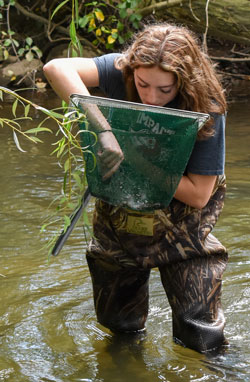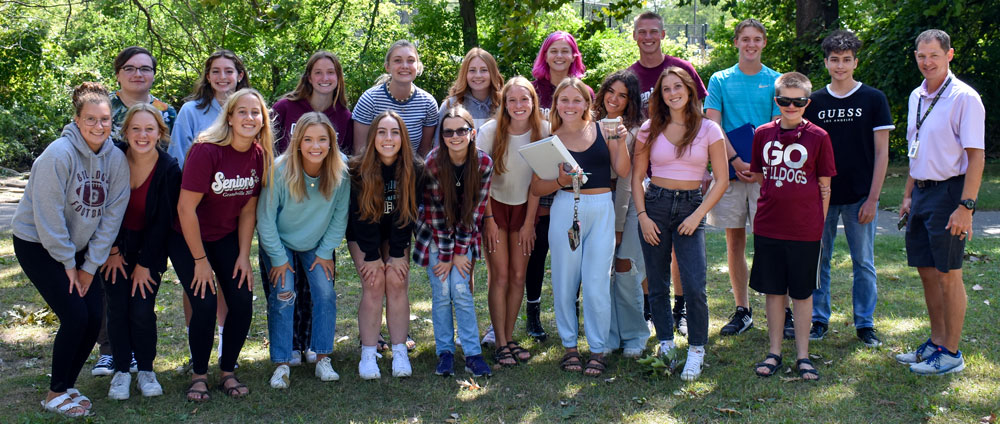Grandville — Armed with buckets, waders, petri dishes, test tubes and clipboards, students in Grandville High School’s AP Environmental Science classes fanned out along the banks of Buck Creek earlier this month to do some water quality testing.

The class is currently studying aquatic biomes, and took the trip out to Wedgewood Park to learn more about the aquatic ecosystem of the creek within the park as compared to the water quality upstream from the park. Some students collected water samples for chemical testing, to determine levels of nitrates, phosphates, dissolved oxygen and pH values found in the water. Others waded into the middle of the creek to stir up sediment and look for macroinvertebrates (bugs).
“We’re going to look at each of the test results and their parameters to make a judgment about whether this is a healthy aquatic ecosystem,” teacher Kevin Randall said. “If it seems like it’s not healthy in any one area, we’ll work to make a judgment about why that is — like maybe there’s an industrial area upstream that’s making the water too warm, or maybe a neighborhood with big yards has lots of runoff from fertilizer.”
Senior Holly Bengston was part of a group testing the turbidity, or amount of cloudiness, of the water. Taking samples from different areas along the creek, they poured water into a tall, skinny tube and then checked to see if the water was clear enough to see the bottom of the tube.
“We measure to see how deep the water is where we can still see the bottom, and then there’s a (math) formula that will give us a specific number for the (water) clarity,” Holly explained. “We want to do it as quickly as possible so that none of the sediment settles at the bottom. Since a stream is constantly moving, we want (the test) to be as natural as possible.”

Mucking About for Bugs
Seniors Ellie Barrett, Hayleigh Heyboer and Sydney Fricassi volunteered to don oversized waders and traipse into the middle of the creek to search for insect larvae and other macroinvertebrates. They took turns gently kicking at the bottom of the creek bed to stir up sediment while the other two used nets and a large cloth to collect what rose to the top. They then sifted through their findings, looking for larvae and other signs of life, and took pictures of their findings for documentation.
This test is done as “a bioindicator of the health of the area,” Randall said. “If we find a lot of biodiversity in an hour and we can count several different types of living creatures, then that gives you a measurement of the health of the ecosystem in one area.”
‘I want my students to make the connections between our daily lives and this neighborhood and this community and what happens to this spot.’
— Kevin Randall, teacher, AP Environmental Science
The creek wasn’t flowing very strongly during their visit, and so the trio didn’t find a large amount of bugs — just a few worms and crayfish. Still, they were eager to bring their findings back to class.
“I’m really interested in the environment and learning how to help it; I love learning about animals and bugs and I love how hands-on this class is,” said Ellie. “I’ve never had a class where we did anything like this and it’s fun getting to be so active out here and do the experiments.
“You get to learn not just by sitting in the classroom looking at a screen or doing papers,” she added. “You really get to, like, get into the environment and do it yourself, which I think is really interesting. I think you can learn a lot more actually doing it, instead of just looking at it.”
While this is Randall’s first year teaching AP Environmental Science, he’s been an active member of the school’s green team for many years, and is a public advocate for more environmentally friendly practices throughout the Grandville community. He plans to take his classes back to Buck Creek in the spring to redo each of these water tests and compare the results.
“I want my students to make the connections between our daily lives and this neighborhood and this community and what happens to this spot,” Randall said. “They have to understand the impacts of what we do and how we live. When we realize the impact that we have, we realize that we can do better, and propose solutions.
“I tell them all the time, we live because of nature, not in addition to it — so if it goes away, we’re in big trouble. And just the fact that they’re interested enough in the topic to take a whole class on it, well, that really gets me.”













